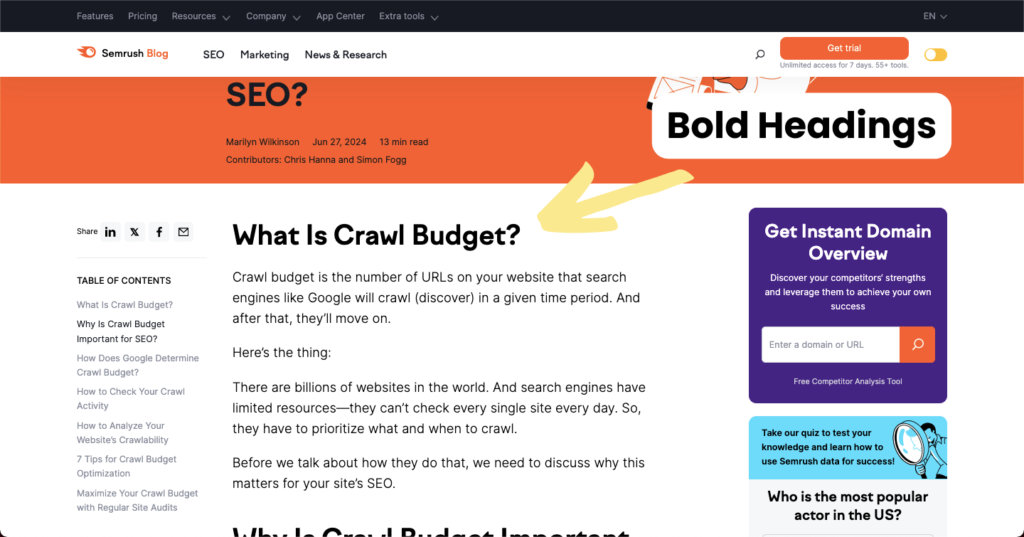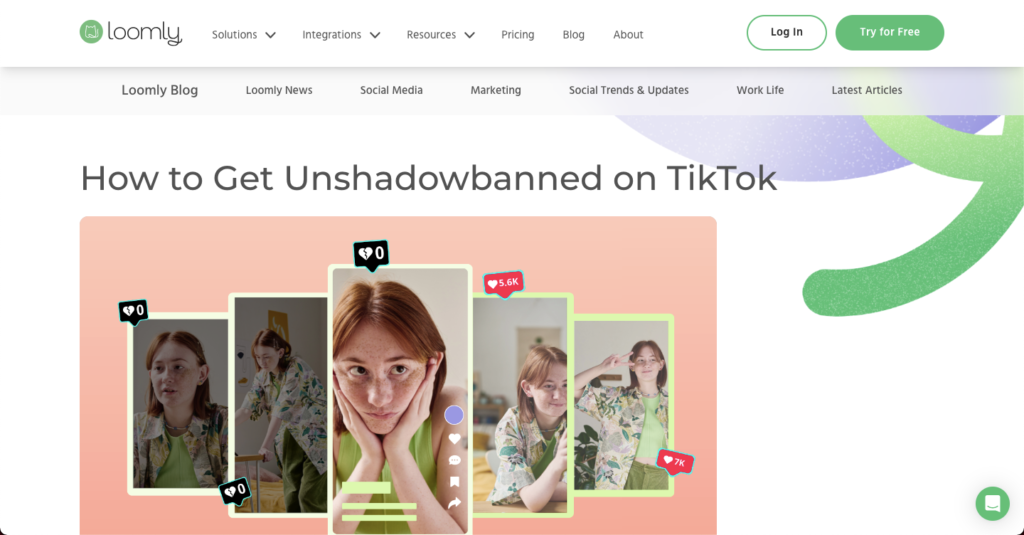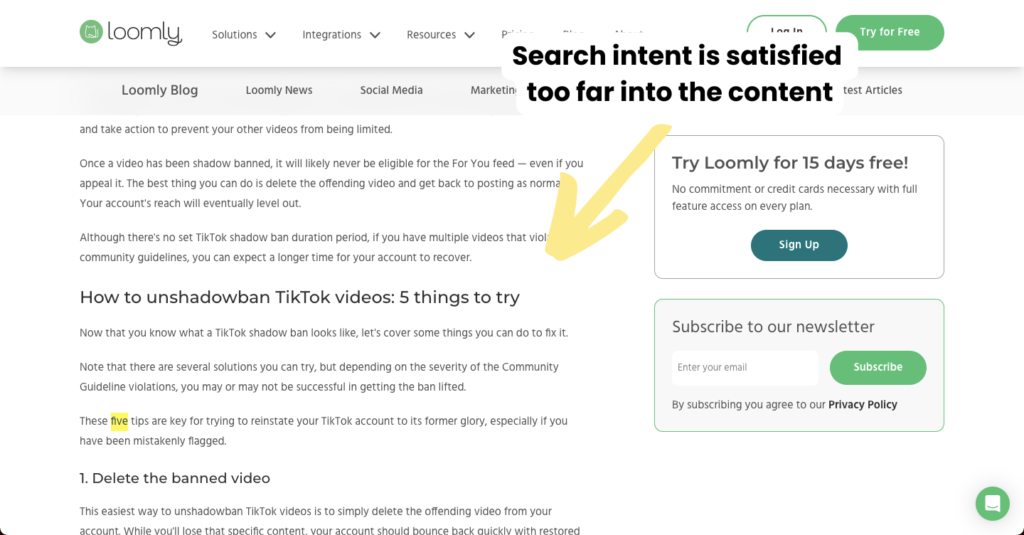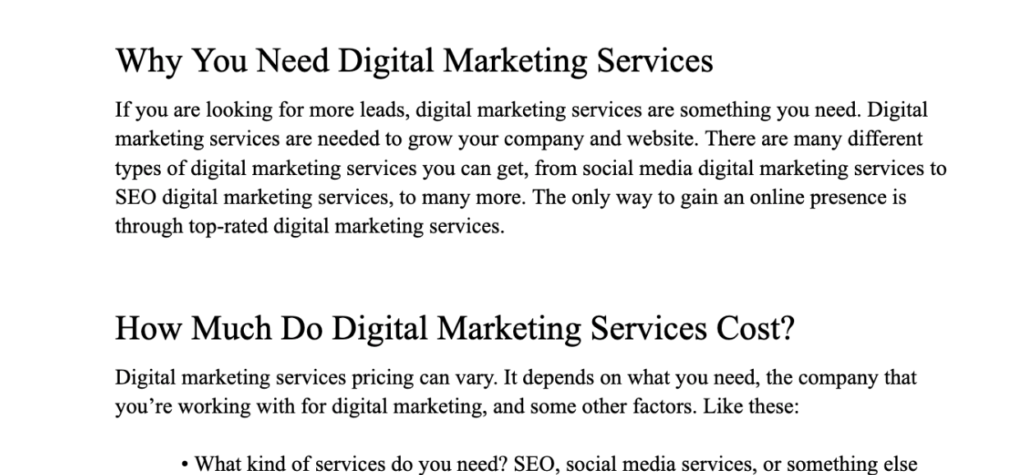SEO is short for search engine optimization. It’s the process of making your website more visible organically in search engines like Google.
It’s a type of marketing that often has high returns. In fact, 49% of marketers claim it has “the best ROI of any marketing channel.”
It’s no shocker why so many companies invest in it — SEO is valuable when done correctly. However, not all companies do it correctly.
I’ve personally seen thousands of sites that do SEO correctly, incorrectly, and everything in between.
Some strategies are great. But others, are downright terrible. In this blog, I’ll show you some examples of SEO from good, bad, and ugly websites. Keep reading to see what they look like.
Great Examples of SEO
Semrush Blog

Semrush is known for their SEO and digital marketing efforts. I specifically love their on-page SEO strategies. Here’s what they do right:
- Great Readability: Their content is super easy to skim. Notice their bold heading structure, large font size, and whitespace. There are no giant blocks of text.
- Captivating Titles: Their title tags are interesting and urge readers to click. They also typically include their main keyword, which helps search engines.
- Keyword Optimization: They include their main keyword in the title, headings, throughout the text, URL slugs, meta descriptions, and more. This optimizes their post for search engines and makes it more likely to rank.
- Subject Matter Experts: Semrush often has their content written by people who are experts on the blog topic. You can scroll down to the author byline and see. This is great for readers and search engines too. Studies suggest you’ll rank better if the author is a subject matter expert… It can also improve your E-A-T score with Google.
- Narrow Container Width: The width of their text is narrow. It’s easy for your eyes to move from one line to the next. This also improves user experience on mobile devices since it fits mobile screens better. Narrow width also plays into good readability.
- Optimized Images: Semrush’s blog images are always helpful to readers. They typically include graphs, relevant quotes, or examples of what’s being explained. Also, their images are compressed to optimize page load speed.
- Floating Table of Contents: Their table of contents is super useful for readers. It stays in the same spot while you scroll. This allows users to skip to whatever section they want without having to scroll endlessly.
Good (But Not Great) Examples of SEO
Loomly Blog

Loomly is a social media management website. They create great blog content. However, like most websites, their SEO strategy isn’t perfect. Here is one specific article titled “How to Get Unshadowbanned on TikTok”. This is an example of SEO that is good but can be improved.
This post is driving tons of traffic and ranking for over 767 keywords. That must mean it’s fully SEO-optimized, right? Wrong.
While this post is optimized in many ways, there are a few SEO mistakes. I believe they could be driving even more traffic if they fixed these mistakes. Here’s what they do right and wrong:
What They Do Right:
- Keyword Selection: The target keyword for their post is “how to get unshadowbanned on tiktok”. This keyword is an excellent choice for many reasons… It’s relevant to their niche, it has high search volume (over 2K monthly searches), high traffic potential, and it’s a low-difficulty keyword.
- Related Posts Section: If you scroll down near the footer, there’s a “related posts” section. This is good for SEO because it can pass link equity and traffic to these other posts.
- Topical Relevance: Loomly writes tons of TikTok-related content. This helps them rank more frequently for any topics related to TikTok. Since this topic is highly relevant to their other content, it’s more likely to rank.
What They Do Wrong:
- Search Intent Issues: The search intent isn’t satisfied properly. Most readers want to see one thing — how to get unshadowbanned on TikTok. However, readers will have to do tons of scrolling to find their answers. The instructions on “how to get unshadowbanned” are almost 1,000 words deep. Positioning them higher could lead to even more traffic.
- Average Readability: Their content is well-written, but could be easier to read. Their font size is small, headings aren’t bold enough, and subheadings are underwhelming.

At the end of the day, Loomly’s article is still amazing content. It ranks well for a reason, even though it isn’t perfect.
Bad Examples of SEO
Some websites are simply clueless when it comes to SEO. Many of them simply don’t know what they’re doing is counterproductive. Regardless, Google’s algorithm will penalize your site for doing spammy practices. Here are a few terrible SEO examples to avoid:
Keyword Stuffing

This website (whose name I won’t mention) posted an article about digital marketing services. It’s pretty clear what their target keyword is. They mentioned the term “digital marketing services” a million times.
This should be good for Google since it’s clear what their keyword is, right? Wrong.
This is called “keyword stuffing”. Not only is it robotic and unnatural, but it goes against Google’s spam policy. This will almost always lead to penalties from the algorithm and less traffic. If your goal is to drive traffic, don’t be like this website.
Links From Spammy Websites
Links act as votes of confidence. They show Google that other sites trust your website. The more quality links you have, the more likely you’ll rank. But, not all links are good links.
If a website has a low authority score, no traffic, traffic trending down significantly, or participates in spammy tactics, avoid them. Getting links from these websites can often hurt your SEO.
Why Do Some Companies Fail With SEO?
Not all SEO efforts succeed. Some websites fail to see results because they target the wrong audience or ignore key ranking factors.
Poor keyword targeting, thin content, and spammy link-building strategies often lead to wasted effort. Even minor mistakes, like improper meta tags, can limit your site’s potential.
Understanding what not to do is just as important as learning best practices. This blog highlights both—the wins and the mistakes—so you can improve your own SEO strategy.
What Makes a Great SEO Strategy?
Great doesn’t just look pretty—it actually works. It solves a problem for the reader. It’s helpful.
Successful use cases typically have clear results. Increased traffic, engagement, leads, or sales often come from good SEO strategies.
Here’s what sets top SEO examples apart:
- They Explain the Strategy Clearly
A good example walks readers through the process step by step. It should leave no room for confusion. For instance, showing how a content update boosted rankings helps readers understand the exact actions taken. - They Include Data and Results
High-ranking SEO blogs often back their examples with data. Numbers prove that the strategy worked. Whether it’s an increase in organic traffic or a jump in search rankings, showing real results builds trust. - They Offer Actionable Takeaways
Top-performing articles always give readers something to act on. They break down complex ideas into simple steps that anyone can try. Adding “how-to” guides or lists of steps improves user experience.
What To Do (& What Not To Do) In SEO
The world of SEO is filled with plenty of good and bad people. While there are tons of sites that strive to make good content, there are also sites that try to cheat the system.
If you’re using any platform to post content, you have to play by those rules. Black hat SEO breaks those rules, while white hat SEO follows the rules. There is also grey hat SEO, which is somewhere in between the two.

White Hat SEO
- Creating Good Content: Creating content that is well written, informative, and accurate.
- Site Performance: Having overall fast website speed—when your site can quickly load images, articles, and other pages.
- Proper Title & Keywords: Having accurate titles for your articles, as well as having good keyword usage and placement.
- High-Quality Links: When your website contains links from reputable websites, usually with higher domain ratings and high traffic. Typically, sites with DR 50 or higher are best.
- User-Friendly Site: A website that is easy to use and navigate.
Black Hat SEO
- Hidden text: Hiding words or phrases on your article, usually by making the writing the same color as the background. Although people won’t be able to see this, Google definitely can.
- Buying Links: Purchasing a link from another website in order to boost your website’s authority. This is seen as an attempt to manipulate Google, since the links to your site are not organic. In some cases this can be considered a grey hat SEO technique.
- Selling Links: Selling links to other websites that link back to your website, or to a different website. This is especially a bad idea if the website you are linking to doesn’t relate to your website and is out of your niche.
- Duplicate Content: Stealing content from other websites, also known as plagiarism. This is not just word for word copying content… An article can also be considered duplicate content if the words are changed significantly.
- Keyword Stuffing: Also known as webspam, this is a strategy where excessive amounts of keywords are placed in a sites meta tags, backlink anchor text, or other content. This is against Google’s spam policy.
- Content Spinning: This is the process of copying another article and changing the wording slightly. There are software tools that are used for this technique, however Google can usually pickup on it pretty quickly. Sometimes this can be considered grey hat, but usually not.
Grey Hat SEO
- Rewriting Content: Another smaller form of plagiarism, this is completely rewriting another article using new wording, usually without adding any value or new content. It is very similar to content spinning, however it is harder for Google to identify if the wording is changed significantly enough.
- Guest Blogging: Although this is not necessarily against Google’s guidelines, some say it is frowned upon. Guest blogging is the process of writing an article for another website in exchange for something—usually money or links.
- Negative SEO: The practice of intentionally buying bad links that link back to your competitor. This often will damage their site authority. As immoral as this is it’s still not considered black hat SEO.



